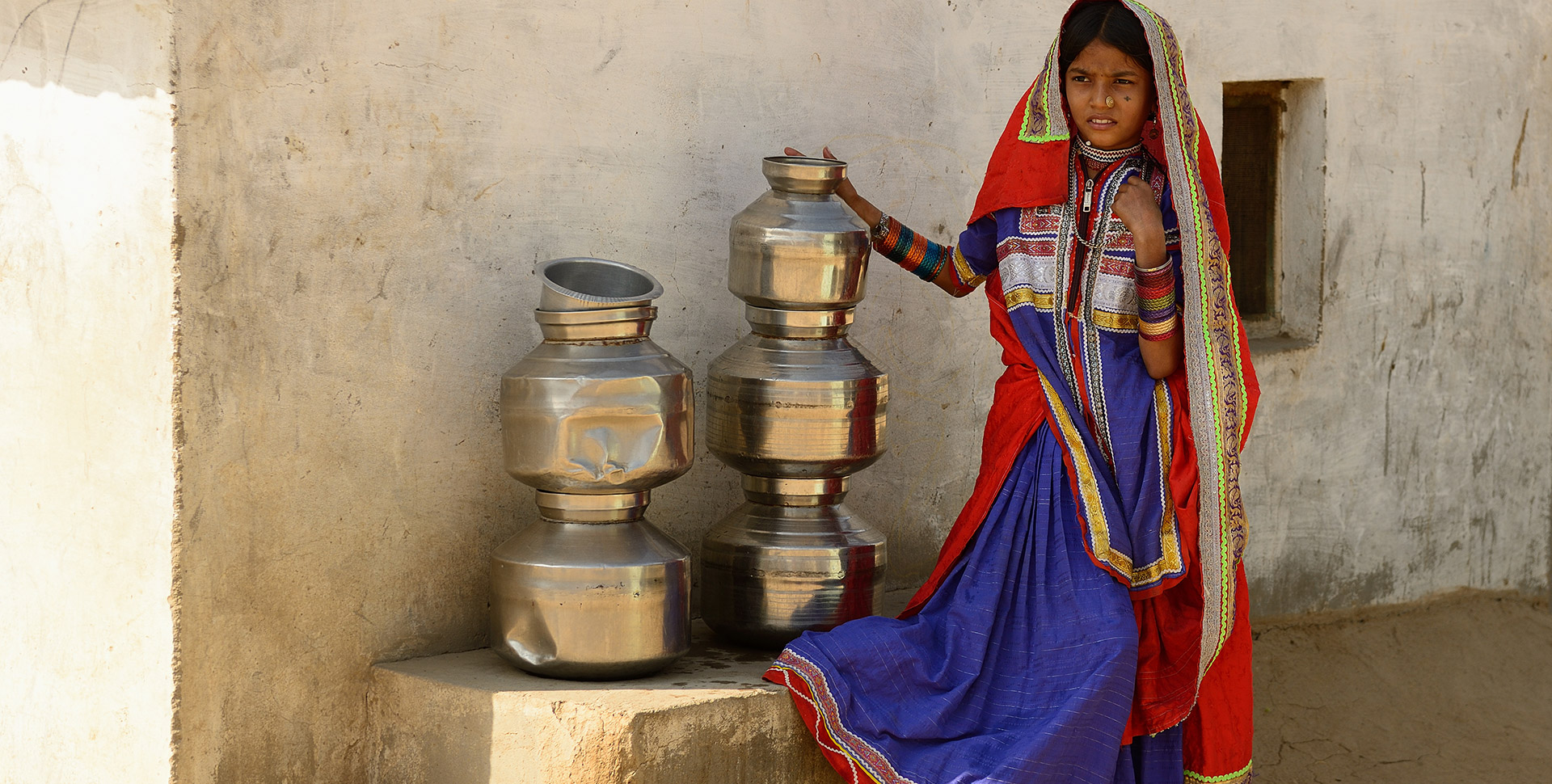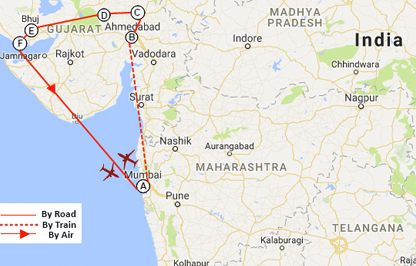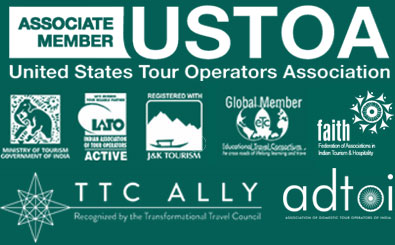Highlights
Best from September to April
Visit to Dhobi Ghat - open air laundry
Heritage walk with CRUTA foundation
Learn textile creation and block printing
Modhera sun temple and double Ikat area of patan know for gems
Explore preserved Bhuj Village life and textile arts
Mumbai – Ahmedabad – Pethapur – Dasada – Bhuj – Mandvi – Mumbaiitinerary
For about 3,000 years, India was the leading manufacturer of cotton textiles in the world from BC 1500 to AD 1500. Gradually, the Indian textile products earned fame and found takers in the Eastern and European markets, which evolved into huge demand during the Middle Ages.
The vibrant state of Gujarat has a rich history in the textiles industry. Ahmedabad received its first modern cotton mill in 1863 and as they say, the rest is history. Frequently termed as the Manchester of the East, Ahmedabad gave a much needed impetus to the industry and today Gujarat stands as the second largest producer of the cotton textiles in India. In fact, the state accounts for almost 8% of the country’s yarn production.
Indus Discoveries brings you this intriguing special interest tour that will unravel the wonderful web of communities connected with this thriving industry, which is an essential part of the cultural heritage of Gujarat.
Day 01 – To Mumbai
Departure from your home country.
Day 02 – Mumbai
Morning arrival in Mumbai. Transfer to the hotel. Afternoon Mumbai city tour includes a visit to the Dhobi Ghat – an amazing open air laundry, which is also the largest one in the world, where washer men use traditional methods of hand washing the laundry. Stay at the Marine Plaza for one night.
Day 03 – To Ahmedabad
Departure from Mumbai by train. This fascinating journey will give you an overview of the landscape of the region. Transfer to the Divan’s Bungalow hotel for 3 nights stay. Dinner and overnight.
Day 04 – Ahmedabad
Start your morning with a heritage walk to the old quarter of Ahmedabad. To give you a complete overview of the old city, a guide will accompany you on that walk. Rajesh Gajjar of CRUTA Foundation (Conservation and research of Traditional Urban architecture) will conduct this walk. Explore the magnificence of the beautiful SwaminarayanMandir in Kalupur and then savour the glory of the architectural legacies at the Jumma Masjid. The next stage of the walk proceeds to the Kavi Dalpatram Chowk–once home of the great 19th century Gujarati poet.
Enjoy a sumptuous lunch in a local restaurant, which will be followed by a visit to the Calico Museum of Textiles in the afternoon. Explore Indian Textiles influenced by the Mughal and Provincial Courts 17th-19th Century and Textile Trade of India and its relation with the outside world – 15th-19th Century. The museum also showcases the Indian Co Regional Embroideries of the 19th Century Clothing in the Calico Collection – 18th to mid-20th Century (Sindh, Kutch, Kathiawad, Tamilnadu, Orissa, Mithila (Bihar), Bengal, Punjab, Chamba (Himachal Pradesh), Indian Tie-Dyed Fabrics, Techniques of Weaving and Dyeing Wooden Blocks for Printing on cloth. Dinner and overnight at the hotel.
Day 05 – Day Visit To Pethapur
After breakfast leave for Pethapur to get bewitched by the intricate geometric or floral motifs, over all or alternate repeats, delicate or bold patterns and block prints, which eulogize the design sensibility of Gujarat. In fact, block printing has remained the mainstay of the oldest surficial textile craft forms in the world and Gujarat is the top destination to explore that. Likewise block carving is another form of textile craft, where the maker leaves a personal impression at every step. The diligent craftsmen, prominent in this art produce these designs as per the requirements of their clients and continue to refine this art with continuous adaptation.
One of the most interesting facets of this art is that all the wood working tools, which are used in this process by the artisans, are mostly designed by them. Kalamkari (Kalam means pen, Kari means work) is another ancient craft, which is used in Gujarat for fabric dyeing and printing. It would be apt to say that in this age of product uniformity, each Kalamkari piece comes with exclusivity and offers a visual delight.
It is a sheer treat for your eyes to watch these artists at work. The beauty of their work and dedication towards that will certainly leave a lasting impression on your mind. The outstanding techniques of craftsmanship, which are used in Kalamkari, have been passed down over the generations. Paintings based on this art can be found in parts of India and Iran.
Visit the Utensils Museum in the evening. Dinner at Vishalla, which serves mouth-watering traditional Gujarati food amidst the village ambiance. Take a walk around the hut-like museum.
Day 06 – To Dasada (Modera and Patan Enroute) [Ahmedabad-Modhera (103 Kms) -Patan (38kms)-Dasada (75kms)]
After breakfast, departure for Modhera Sun temple, which showcases one of the finest examples of the Indian architecture of that period. Built in 1026 A.D. the magnificent temple is believed to be the abode of the Sun-God, Surya. Each and every part of this temple has been diligently carved with Gods and Goddesses, birds, beasts and flowers.
After a visit to the Sun Temple, leave for Patan to experience the eminence of the rich heritage of Double Ikat. Double Ikat Patola from the area of Patan is known for its gem like qualities, stunning colours, designs & durability. This is the reason why it attracts connoisseurs of fine textiles.
Next visit to Rani-Ki-Vav - a majestic stepwell, located on the banks of the Saraswati River, which shows the interesting form of the subterranean water resource and storage systems constructed since the 3rd millennium BC. Stay at Rann Riders for 2 nights.
Day 07 – Dasada
Morning desert safari takes you across the Little Rann of Kutch, also known as a salt marsh. Afternoon tour through the settlements and villages along the Rann of Kutch, famous for their embroideries. Little Rann of Kutch is home to an interesting ethnic community known as Rabaris. Once a nomadic race, Rabaris still have an interesting lifestyle and customs. Most of the Rabaris are now permanently settled, though some still lead their lives as semi-nomadic - as they raise cattle, camels and goats in the arid deserts of Kutch and western India.
The settled Rabaris live in small hamlets either in villages or in small towns. Sometimes they jointly live with other ethnic communities. Interestingly, it is easy to identify Rabaris, especially their women folks, who wear long black head drapes and typical heavy brass earrings. Many interesting animals roam around in the Little Rann of Kutch i.e. Blackbuck or Indian Antelope, Nilgai and Chinkara or Indian gazelle among others. You can also spot carnivores including the endangered Indian wolf, desert fox, Indian fox, jackals, desert and jungle cats, and a few hyenas. In birds, you can spot flamingos, pelicans, ducks, cranes and storks. Dinner and overnight at the hotel.
Day 08 – To Bhuj
Drive to Bhuj, capital of the fascinating Kutch region. En route stop at Dhamdka, Azrakpur, then stop at Khamir (Kutch Heritage Arts Music information and Resources centre), where Mr Harish Hurmade will give you a clear insight into the mesmerizing rural crafts of Kutch. Enjoy home-made lunch at Khamir. Later visit Bhujodi on way to Bhuj. Dhamadka is the main centre of the Ajrakhblock printing technique. Later visit Ashapura Crafts centre and Shrujan (an NGO).
Explore another major textile centre of Kutch with a visit to Bhujodi, a small town 8 kms southeast of Bhuj. The vast majority of the 1200 inhabitants of this area are involved in the textile handicraft production. Meet weavers, tie-dye artists and block printers, most of who belong to the Vankar community. Watch them working. Stay at the Kutch Safari Lodge for 3 nights. Dinner and overnight at the hotel.
Day 09 – Bhuj
Visit to some quaint little villages, which are also the last villages on the India-Pakistan border. Meet some master craft people showcasing their traditional art and creating some master pieces every day. Whether it is their ornaments, clothes, utensils, or things that they use every day, it will take you back in time and leave you enthralled.
The fine work of textile arts has been preserved by almost each and every community and caste living in these semi-arid regions of Saurashtra and Kutch. Enjoy a full day's safari to explore the Kutchi village communities and explore the traditions and daily lives of the artisans.
Day 10 – Bhuj
Morning visit to the Kala Raksha Kendra, which shows some outstanding examples of crafts. The museum showcases textiles design and art samples, taken from the communities with which this Kendra works. Each object at this Kala Raksha Kendra offers this collection of crafts, complemented by documentation. There is also a library of books on textiles and related topics; with over 200 volumes- many of them contain rare archives of designs, photographs and slides. Rest of the day at leisure. Dinner and overnight at the hotel.
Day 11 – To Mandvi
Drive to Mandvi where you stay in Serena Beach Resort for 2 Nights. Dinner and overnight at the hotel.
Day 12 – Mandvi
Free day. Dinner in the hotel.
Day 13 – To Mumbai
Drive to Bhuj airport and fly to Mumbai. Transfer to the Marine Plaza for one night. Dinner and overnight at the hotel.
Day 14 – On the final day
Departure for your home country.
Each of our programs can be customised to our client’s desires.
Accommodation
- Luxury hotels.
- Camp Accommodation
- Can be customized according to requirement.
Tour Inclusions
- Assistance upon arrival and departure at airports and railways stations
- Accommodation
- English Speaking Guide and entrance charges as indicated in the itinerary
- All domestic transfers within the country
- Complimentary drinking water


 +1-(765)-586-1210
+1-(765)-586-1210 +44-2030-2689-44
+44-2030-2689-44 +91 124 4361906
+91 124 4361906



 +1-(765)-586-1210
+1-(765)-586-1210 +44-2030-2689-44
+44-2030-2689-44

